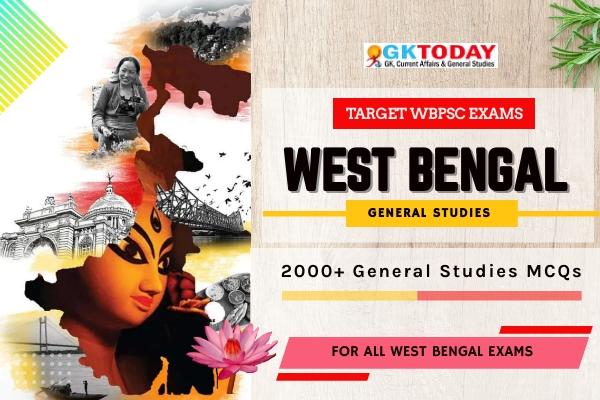States PCS: West Bengal GK Questions for WBPSC Examinations
For all West Bengal Public Service Commission (WBPSC) exams including WBCS, JE, AE, and other state-level competitive examinations.
11. In which year did the Battle of Buxar is fought?
[A] 23rd October, 1765
[B] 3rd October, 1765
[C] 3rd October, 1764
[D] 23rd October, 1764
Show Answer
Correct Answer: D [23rd October, 1764]
Notes:
Due to conflict between Mir Qasim and Company rule, the Battle of Buxar was
fought on 23rd October, 1764 between the forces under the command of the British
East India Company.
12. In which year the
Permanent Settlement was introduced in Bengal?
[A] 1793
[B] 1790
[C] 1789
[D] 1792
Show Answer
Correct Answer: A [1793]
Notes:
Lord Cornwallis introduced the
Permanent Settlement in Bengal in 1793. Permanent Settlement was an agreement between the British East
India Company and the landlords of
Bengal to settle the land revenue.
13. Who composed Vande Mataram?
[A] Rabindranath Tagore
[B] Saratchandra Chattopadhyay
[C] Kazi Nazrul Islam
[D] Bankim Chandra Chattopadhyay
Show Answer
Correct Answer: D [Bankim Chandra Chattopadhyay ]
Notes:
Bankim Chandra Chattopadhyay, was an Indian novelist, poet and journalist. He was the composer of Vande Mataram, originally in Sanskrit, personifying India as a mother goddess and inspiring activists during the Indian Independence Movement.
14. Who originally started the newspaper Shome Prakash?
[A] Iswar Chandra Bidyasagar
[B] Raja Ram Mohan Roy
[C] Prafulla Sarkar
[D] Ganga Kishore Bhattacharya
Show Answer
Correct Answer: A [Iswar Chandra Bidyasagar ]
Notes:
The original plan of Shome Prakash was mooted by Iswar Chandra Bidyasagar (1820-91). He was an Indian Bengali polymath and a key figure of the Bengal renaissance.
15. In which year did Sister Niveditha start her school for girls education?
[A] 1989
[B] 1888
[C] 1988
[D] 1898
Show Answer
Correct Answer: D [1898]
Notes:
On 13 November 1898, on the day of Kali Puja, at 16 Bosepara Lane in the Bagbazar area of Calcutta, Sister Niveditha started the school for girl’s education. The school was inaugurated by Sarada Devi, in the presence of Swami Vivekananda and some of the other disciples of Ramakrishna.
16. Who is the father of Bengali sonnet?
[A] Henry Louis Vivian Derozio
[B] Michael Madhusudan Dutt
[C] William Bentinck
[D] None of the above
Show Answer
Correct Answer: B [Michael Madhusudan Dutt]
Notes:
Madhusudan Dutta’s most notable work in Bengali is Meghnad Badh Kavya, a tragic epic in nine cantos which was constructed in the Greek poetic tradition. Dutt also wrote poetry concerning the sorrows and afflictions of love as spoken by women. He was called as the father of Bengali sonnet.
17. Chinnapatra was a collection of letters sent between–
[A] Rabindranath Tagore & Indira Devi Chaudhurani
[B] Rathindranath Tagore & Indira Devi Chaudhurani
[C] Satyendra Nath Tagore & Indira Devi Chaudhurani
[D] Surendranath Tagore & Indira Devi Chaudhurani
Show Answer
Correct Answer: A [Rabindranath Tagore & Indira Devi Chaudhurani ]
Notes:
Indira Devi Chaudhurani (29 December 1873 – 12 August 1960) was an Indian literary figure, author and musician. She is noted for her work in scoring the music for a number of songs by her uncle Rabindranath, with whom she was particularly close, and the author’s letters to Indira were later published as Chinnapatra.
18. Which only Indian city has operated tramways since 1902?
[A] Delhi
[B] Mumbai
[C] Kolkata
[D] Pune
Show Answer
Correct Answer: C [Kolkata]
Notes:
Calcutta Tramways Company is a state-run company that operates trams and buses in and around Kolkata in West Bengal, India. The Kolkata tram is the only operating tramway in India and is the oldest electric tram in India, operating since 1902.
19. Which is one of the largest paper markets in India situated at Kolkata?
[A] Baithakkhana Paper Market
[B] College Street
[C] Burrabazar
[D] Bowbazar
Show Answer
Correct Answer: A [Baithakkhana Paper Market]
Notes:
Baithakkhana Paper Market is one of the largest paper markets in India. However, the letterpress business, once the largest printing process in the country and the pride of Bengal, has lost out to more modern systems.
20. Which district of Bengal used to be the capital before Calcutta was founded?
[A] Nadia
[B] Burdwan
[C] Murshidabad
[D] Birbhum
Show Answer
Correct Answer: C [Murshidabad ]
Notes:
The Murshidabad city, which lends its name to the district, was the seat of power of the Nawabs of Bengal. A few years after Nawab Siraj-ud-Daula lost to the British at the Battle of Plassey, the capital of Bengal was moved to the newly founded city of Calcutta in 1970.

